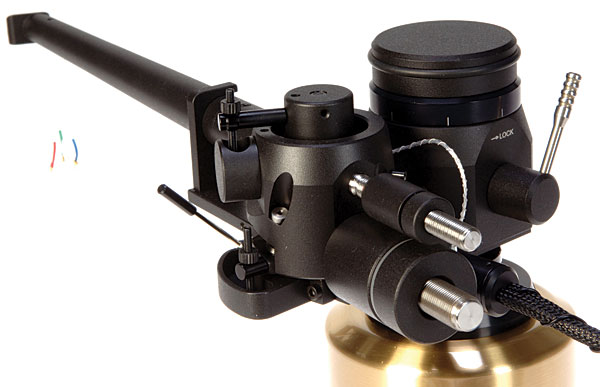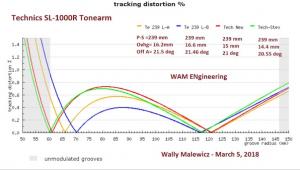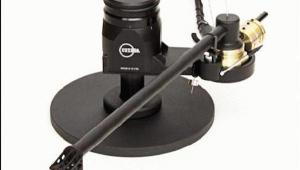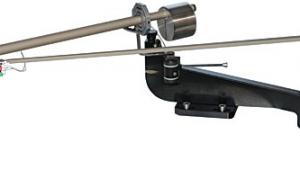Kuzma 4Point tonearm Page 2
In this arrangement, the external sleeve is kept from moving in any unwanted direction, which is critical: two additional cups are affixed to the aforementioned sleeve "shelf," which is attached to the horizontal bearing sleeve. Two precisely angled points attached to the lower surface of the removable tonearm assembly engage the angled cups affixed to the shelf, providing the arm's vertical motion.
Thus you have four points contacting four cups (three circular, one elongated) that permit the arm to move in both the vertical and lateral planes, minus the chatter of gimbaled bearings and the instability of unipivots. Brilliant!
The Rest of the Design
The bearing system described above is offset from the tower assembly for adjusting vertical tracking angle (VTA), with its locking vernier dial, all superbly engineered and machined. This is an adaptation of the one in Kuzma's Airline arm. This arrangement has a precedent in Herb Papier's Tri-Planar arm (formerly the Wheaton Tri-Planar) of the 1980s, which also had a VTA adjustment tower and offset bearing. A benefit of this system is that it permits rotation of the bearing around the tower. Thus, the 4Point's 11"-long arm could be accommodated by the mounting platform that Continuum Audio Labs designed and built, to allow me to use the 9"-long Graham Phantom on the Caliburn 'table's second arm mount.
The 4Point's tapered, two-piece aluminum armtube is borrowed from earlier pivoted Kuzma arms. Azimuth can be precisely and easily adjusted by loosening two screws, inserting an Allen key in a hole, and turning it. Lines on either side of the tube allow you easily to return to an angle of 0°.

Also borrowed from the Airline is the 4Point's rigid, angled-construction headshell—but this one is removable, thanks to a short, beefy, hexagonal protrusion that fits securely into a matching opening on the arm and locks tightly with a grub screw atop the arm. A tiny threaded hole lets you screw in the finger lift, if you want it.
Try this system and you won't lose a minute's sleep worrying about a loss of rigidity or azimuth stability, or about adding an electrical break: the cartridge wires and clips protrude from an opening just behind the connector. This arrangement makes swapping out cartridges fast and relatively inexpensive, given that you only need extra headshells rather than armtubes (Graham) or entire tonearms (VPI). The cartridge overhang is preset. All you have to do is reset the previously established vertical tracking force (VTF), antiskating, azimuth, and VTA, all of which this design makes relatively easy.
Two wires attach to each cartridge clip. At the other end of the arm are two termination points: one is a pair of Eichmann RCA Bullet plugs at the end of a 1.4m-long cable of high-quality silver wire, the other a box with a pair of Cardas RCA jacks. Thus you can choose to run direct out, or via your favorite phono cable, or both (to parallel the value of the desired load when connecting to two inputs of the same phono preamp).
The counterweight system is as ingenious as everything else about the 4Point. It has two threaded shafts: the larger of which is below the vertical pivot point, and is used to establish the arm's basic balance with an assortment of weights and damping washers; the smaller, upper shaft is used to set the actual VTF. This way, most of the counterweight's mass can be just where you want it: close to the pivot point.
Antiskating is set via a familiar mechanism of thread, cam, and weight, attached to the platform that holds the armrest and the cuing mechanism, itself attached to the bearing platform. The 4Point's effective length of 11" means that it needs less antiskating force than would a shorter arm.
Kuzma has also provided for separate, easily adjustable vertical and horizontal damping, using the familiar system of a paddle in a trough filled with silicone fluid.
Other pertinent stats include a pivot-to-spindle distance of 264mm, a spindle-to-VTA-platform center distance of 212mm, and, most important, an effective arm mass of 13gm.
Setup and Use
Thanks to excellent instructions, photos, supplied tools and accessories, installing the 4Point was relatively easy. On the Continuum Caliburn turntable, however, I couldn't meet Kuzma's specified pivot-to-spindle and spindle-to-base distances; a workaround was required to achieve proper cartridge alignment. I won't go into the details here. However, the 4Point uses a 40mm post-and-collar mount. Kuzma can supply collars compatible with virtually any mounting system, assuming your 'table can accommodate the post's depth and the tonearm's weight (over 3.5 lbs).
Otherwise, setup was straightforward for all parameters. Equally important was the ease with which I could swap out headshells. The feel of the 4Point was superb: It had the stability of the best fixed-gimbaled arms, and felt virtually frictionless. Lift the cuing arm, then lower it, and the stylus returns to the groove it just left. Lower the stylus into the lead-in groove, and it never stumbles, slides, or jumps into the first track.
Love at First Sight
A few years ago, when I first saw the 4Point, it was love at first sight—this tonearm's physical appearance just about screams stability and certainty. And, it turned out, so did the sound it didn't produce.
I set up a 4Point in Stockholm last winter, when I gave seminars in turntable setup at an audio show there, but I never got to hear it. Now that I've installed it on the Continuum Caliburn, I realize how unfair I was to the Brinkmann 9.6 tonearm ($3990) I reviewed in the May issue. Of course, the Brinkmann wasn't as good as the 4Point. I'm not sure anything is, even the Continuum Cobra. . .
- Log in or register to post comments


I noticed that in your review of the Kuzma 4Point 9 in the current issue of Stereophile (June 2018 issue) that you make mention of the fact that this new arm is more compatible with the Linn LP12 platform. Unfortunately, this is reported to actually NOT be the case! There are several users in Europe who have tried this combo, all have been severely disappointed! The suspension of the Linn requires a very light weight arm...along with cabling that has no way of interfering with the subchassis and bounce. As a current LinnLP12 Radikal D owner, I know this as a fact. The LP12 is VERY unforgiving when it comes to arms and the compatibility with weight, design etc. Did you happen to check the new Kuzma 4point 9 on a LP12 table?













































